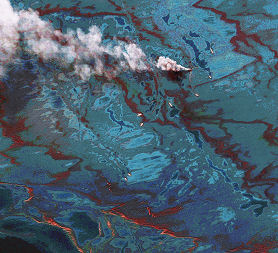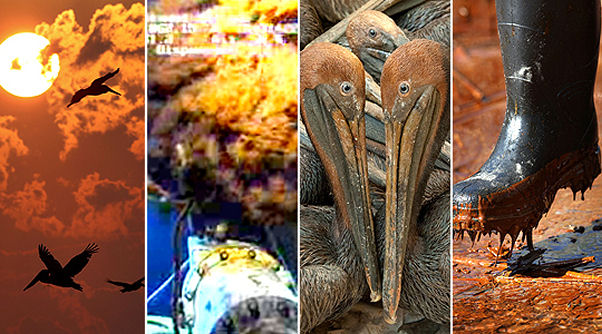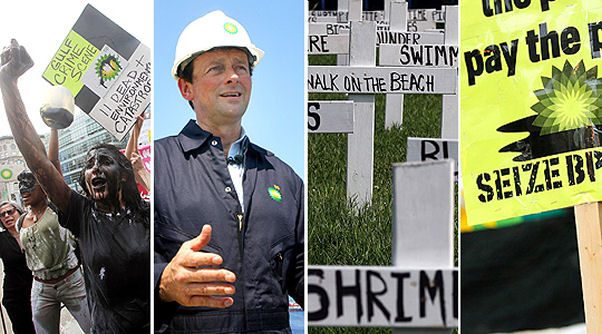BP oil spill: timeline of events
As costs of the BP oil spill clean-up surpass a billion dollars, Channel 4 News runs through the timeline of events that led to the biggest oil slick in US history.

20 April 2010
Deepwater Horizon rig explodes, 11 workers killed. The rig was licensed to BP, drilling for the oil giant’s Macondo project at a depth of 5,000 feet.
21 April
115 remaining workers evacuated from rig.
22 April
Deepwater Horizon, worth in excess of $560m, collapses into the sea – producing a 5-mile long oil slick.
25 April
Efforts to activate the well’s blowout preventer fail.
28 April
The US Coast Guard warns that the oil spill could become the worst in American history, announcing that 5,000 barrels of oil a day (210,000 gallons) are leaking into the Gulf of Mexico – five times greater than initial estimates.
29 April
US President Barack Obama pledges “every single available resource”, including the military, to contain the spill. Louisiana declares a state of emergency, Obama says BP is responsible for the clean up.
30 April
The US government rules that there will be no drilling in new areas until the cause of the accident is known.
BP says it will pay all legitimate claims and the cost of the clean-up.

2 May
Obama makes his first visit to the Gulf Coast. BP begins work on the first relief well.
6 May
Oil reaches the shores of the Chandeleur Islands off the Louisiana coast.
7 May
BP’s ‘top hat’ attempt to place a dome over the top the well fails.
10 May
BP gains US approval to spray chemicals on the oil spill.
14 May
Obama slams BP and partners over the“ridiculous spectacle” of trading blame for the oil spill – after executives from BP, Transocean and Halliburton appear at Congressional hearings in Washington
18 May
The US almost doubles its no-fishing zone to 19 per cent of US waters in the Gulf of Mexico.
20 May
Greenpeace activists scale BP’s headquarters in London, hoisting a flag over the oil giant’s entrance with the words “British Polluters”.
21 May
BP launches alive camera of the leak, as its containment rate drops to just 2,000 barrels a day.
26 May
BP starts its ‘top kill’ operation to block the oil well with mud and debris.
28 May
Obama’s second tour of the Louisiana coast. “I am the president and the buck stops with me,” he says.
29 May
BP chief executive Tony Hayward makes his first trip to the Gulf.
30 May
BP’s top kill plan fails. White House adviser warns the spill is “the biggest environmental disaster” ever faced by the US.

1 June
BP loses a third of its market value after its shares plunge as much as 17 per cent during the day’s trading.
US launches a criminal and civil investigation into whether BP broke any laws in its handling of the oil spill.
4 June
BP fits a containment cap onto the well using remote control robots.
5 June
Obama’s third visit to Louisiana, the president brands the spill “brutally unfair”.
6 June
BP says it has captured 10,500 barrels of oil (439,950 gallons) in the last 24 hours.
7 June
BP announces that total clean-up costs have now reached $1.25 bn
8 June
Obama reacts to criticism over the US government’s handling of the disaster, saying he needs time to look for “whose ass to kick”.
9 June
White House demands BP cover all costs of the oil spill in the Gulf of Mexico, including millions of dollars in salaries of workers laid off as a result of Obama’s suspension of drilling in the area. BP shares fall 15 per cent on Wall Street.
10 June
David Cameron says the UK government “stands ready to help” BP, with plans to discuss the crisis with Barack Obama.
11 June
The US Geological Survey doubles its estimate of the oil spill, announcing that as many as 40,000 barrels (1.68m gallons) of oil a day may have been spewing from the ruptured oil well before BP fitted a cap.
12 June
Cameron and Obama hold 30-minute-long phone conversation. The President says his comments about BP have “nothing to do with national identity”.
14 June
President Obama says the Gulf oil spill disaster “echoes 9/11” as he arrives in Alabama for his fourth visit.
15 June
BP is downgraded by ratings agency Fitch, whose estimates of the clean-up bill double to a maximum of $6 bn.
Obama gives his first televised address from the Oval Office vowing to make the oil giant pay, and campaigning for a greener future.
16 June
BP chairman and executives meet with Obama at the White House and agree to set up a $20bn fund to cover damages, as well as suspending the group’s dividend for the rest of the year. US president drafts in America’s “modern-day King Solomon” to head up the fund.
17 June
BP chief executive Tony Hayward faced a US congressional hearing. Hayward was repeatedly accused of ignoring safety warnings, shirking responsibility and running a company with “astonishing” corporate responsibilty.
19 June
Tony Hayward is seen on his boat at the Isle of Wight ‘Round the Island Race’, prompting Rahm Emanuel, President Obama’s chief of staff, to observe that this was another in a “long line of PR gaffes”.
21 June
Shares in BP fall again, after the oil giant admits costs have risen to $2bn and some City fund managers describe the group as ‘dead stock’.
25 June
BP shares fall to fourteen year low over fears that a hurricane could disrupt the clean-up operation.
28 June
Costs of the oil spill rise to $100,000 a day, as BP warns of approaching tropical storm Alex.
10 July
BP begins a complex operation to place a new cap over the leaking oil well.
13 July
BP successfully lowers another cap on the leaking well and prepares to test it.
14 July
US senators call for an investigation of BP’s Libyan business interests, accusing the oil giant of lobbying for the early release of the convicted Lockerbie terrorist – with plans to use “blood money” to pay off victims of the Gulf spill.
15 July
BP begins crucial 48-hour test of new oil containment cap in the Gulf.
16 July
BP shares soar at the announcement that oil has stopped spewing out from the leaking oil well in the Gulf of Mexico for the first time since April.
18 July
US government releases a letter to BP Chief Managing Director Bob Dudley, referring to an unspecified seepage near the well, along with “undetermined anomalies at the well head”.
27 July
Tony Hayward steps down as chief executive and is to be replaced by Bob Dudley, BP’s first American chief executive. BP reports its first quarterly loss in 18 years and reveals that it has set aside £20.8bn to pay for the clean-up of the Gulf of Mexico, including the $20bn escrow fund.
4 August
BP deems the “static kill” operation a success. US government scientists estimate that 4.9bn barrels of oil have leaked into the sea since the Deepwater Horizon explosion – pushing BP’s potential fine up to $21bn.
